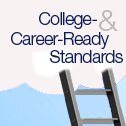How are states’ colleges and universities using high school test scores in course-placement decisions? Do high schools’ course requirements match up with minimum admissions standards in states’ higher education systems? And do all states even have definitions of what it means to be “college ready”?

Those are some of the questions answered in a new interactive report from the New America Foundation, “Mapping College Ready Policies.” Put together by New America policy analyst Lindsey Tepe, the analysis shows that states have made some progress in creating a more coherent transition from K-12 to higher education through assessments and other means, but that in many states there are still disparities between what students must do to earn a diploma and what they must to do to earn a spot on a college campus.
To get the information, New America looked at state education department web sites and in some cases their approved waivers from the federal No Child Left Behind Act.
So, for example, Tepe asked the question: Have states or systems of higher education adopted course-placement policies that are aligned with high school assessment? Here’s how the 50-state (and the District of Columbia) answer looks—click to enlarge the map:

The various colors on that map illustrate why it’s a notable story when universities in six states, including California, agreed to use scores from the Smarter Balanced test for course-placement purposes. (Both Smarter Balanced and Partnership for Assessment of Readiness for College and Career exams are designed to assess students on the Common Core State Standards.)
Here are a few other pieces of information from the report:
- Only six states have high school course requirements for graduation that are aligned with minimum course requirements for college admission, while in 16 states requirements for K-12 and higher education that are partially aligned.
- States are using 14 different combinations of assessments to measure college- and career-readiness. For example, five states are using both the ACT exam and PARCC test to do so, while two states are using ACT, Smarter Balanced, and their own separate state tests.
- Twenty-six states have the same definition for both “college ready” and “career ready.” And 18 states have no definition at all.
Tepe’s report comes right on the heels of a neat feature from National Public Radio detailing how states have various paths to earning a diploma, and how some states’ requirements are more taxing than others and don’t always match what tests like the ACT say about students’ preparedness for postsecondary academic work. I wrote about an Achieve report on the same topic back in February.
Yet analysts and others involved in college readiness also stress that states should try to ensure as many college-access points as possible through dual-credit and other pathways to higher education, at the same time that they focus on having high-quality standardized tests.
Click the first link in this post, and then click on a state on Tepe’s map to learn more details about that state’s policies.
